11/3-11/8
1850.91 km from Canterbury
Leaving Lucca, we walked just a short distance to Altopascio. This is a cute little town that was founded between two vast malarial marshlands in the Middle Ages. The town has a famous bell called "La Smarrita," which means "the lost," in its bell tower. Traditionally La Smarrita tolled to summon the pilgrims lost in the swamps to safety! Now the swamps have been completely consumed by fields, and straggling towns though so Chad and I didn't get malaria... or lost...
 |
| Leaving the Renaissance walls of Lucca |
 |
| A very wet walk to Altopascio |
Altopascio was a very quaint and small town. Our pilgrim accommodation faced the bell tower and a quiet piazza below. We met Marie at the hostel again as well as Joachim. Marie had arrived in Lucca the day before we had and said that it was so crowded she couldn't explore at all! She ended up wading through the crowds and stayed further on. So I guess it was lucky Chad and I decided to stay the previous night in Valpromaro!
 |
| Altopascio church facade |
 |
| View of the bell tower from our window! |
Our walk the next day was another long damp one. Despite this, it was a very interesting walk! I was super excited that we would be walking a portion of the original graveled surface of the Via Francigena-Roman road!! This gravel had been unearthed during recent archeological digs, and now pilgrims to Rome can walk along its path again! Chad was less impressed, but as per usual he was a good sport to my nerdy fancies!
 |
| Sign for the Via Francigena |
 |
| The Original Roman road! |
There was once a small town here situated around the Via Francigena with a hospital for pilgrims. This hostel was abandoned in the middle of the 14th century after the plague and in its place sprouted the Greppi hostel which is still present as a waymarker for pilgrims!
 |
| The Greppi Hostel |
There was also a bridge near Greppi that had been reconstructed in the 20th century over the remains of the original bridge.
 |
| It was actually easier to walk on the side of the gravel road! |
From the Roman road, we crossed through a small town and into a very muddy section of the route. The earth around us was very orange-red and dyed our shoes rust colored!
 |
| Way-marker showing the route from Fucecchio to San Miniato |
 |
| This section was extremely muddy and difficult to traverse! |
Around mid-afternoon, we crossed the bridge at Ponte a Cappiano. This bridge used to have a pilgrim hostel on it! While we did not stay there, we quite enjoyed the caution sign at the head of the bridge...
 |
| Warning Pilgrims! |
The remainder of the walk to San Miniato was beneath relatively clear skies!
 |
| Tiny toe beans! |
 |
| A carnival preparing to open |
 |
| Crossing over the Arno River |
 |
| We walked along this ridge for several kilometers-- you can see Frederic's Tower of upper San Miniato in the distance. |
 |
| Kitties! |
In San Miniato, we stayed at a pilgrim hostel that was attached to an old-folks home in the lower town. The historical town of San Miniato sprawls along a high ridge a steep climb from the modern section in the valley below. That night Chad and I slept in a tiny bunk room with Joachim who wanted to let us know that he "snoozes." Our confused faces prompted him to explain what "snoozing" is and that is what the French (or the Portuguese?) call snoring! While it was no issue for me (I'm half deaf and a heavy sleeper) poor Chad hardly got any sleep that night, this didn't endear Joachim to Chad at all!
The climb to upper San Miniato was very difficult the next morning as we were walking in heavy rain again! The upper town was very picturesque, but we didn't look around much and quickly ducked into a bar to dry off and eat (a nice break after 45 minutes of walking!)
Next to the bar was a tiny little brick church dedicated to Saint Rocco and Saint Sebastian, two saints of plague. The chapel had been built in 1524 during a time of plague and inside it was covered with very creepy modern frescoes!
 |
| Creepy frescoes |
Our walk that day wasn't particularly long or arduous, so we took our time at the bar and leisurely set out for Gambassi Terme. Luckily most of the rain held during the day, but the damp weather and clouds made the day a cool one. Despite the ominous weather, the views around were beautiful, and Chad and I enjoyed the scenery as we entered the picturesque Tuscan hills.
The path traversed through vineyards and olive groves rolling through the low hills.
 |
| Olive groves |
We found that the Tuscan hills were made of the same clay earth that we had encountered crossing the Apennine Mountains so, combined with the wet weather, we were in for even more slippery mud trekking! During one descent we had to walk down a very steep and muddy clay road, I followed Chad, and we slipped and slid down the muddy abyss to the bottom!
As the day progressed, we realized that we were running out of daylight and we still had several kilometers until we reached Gambassi Terme. The cloud cover was looking more and more sinister as well, though I do have to say that the apocalyptic clouds make for some beautiful photography!
We passed through the minuscule hamlet of Coiano where there was a parish church being restored that was mentioned as a stopping place for Sigeric!
 |
| Muddy muddy muddy |
The route between Lucca and Viterbo was through beautiful rolling hills with vineyards and cyprus trees lining the roads. It was truly a beautiful area to walk through! Other than the rain it was usually a pleasant cool temperature with gorgeous roiling clouds.
 |
| Tuscan farms below |
Unfortunately it got dark when we were about eight kilometers from Gambassi Terme. The cloud cover didn't help and to make matters worse it started raining hard just as the sun set at five!!
At this point I must digress... I don't think I have ever properly talked about our rain gear so just let me tell you! I was well prepared and had a poncho and waterproof pants and jacket, Chad, on the other hand, had a rain jacket and a too-small poncho that we got here in Italy. I usually didn't do too badly in the rain unless it was raining very hard. Poor Chad was not so lucky! Every time Chad moved his upper body or the wind gusted his poncho would pop open and he would need me to stop and fix it. To make matters worse, the water would fall directly from his poncho into his shoes like a funnel, so the only way to assuage this was to hold his palms out like he was holding a tray and just let the rain water collect in a little pool between his arms. When we stopped, he would lower his arms away from his feet and let loose a deluge of rain water! So needless to say we weren't the happiest of campers by the end of the night!
 |
| The tumultuous Tuscan skies! |
By 5:30 it was dark, windy and rainy and we had to walk for the last hour uphill near a busy road! When we finally made it to the parish church at 6:30 we received a lovely welcome! They were so nice and had been worried we weren't going to make it. They led us up to our room (which was practically a hotel room!) and cooked us a hearty dinner. The beds were nice and clean with fresh sheets! Chad and I felt so spoiled!
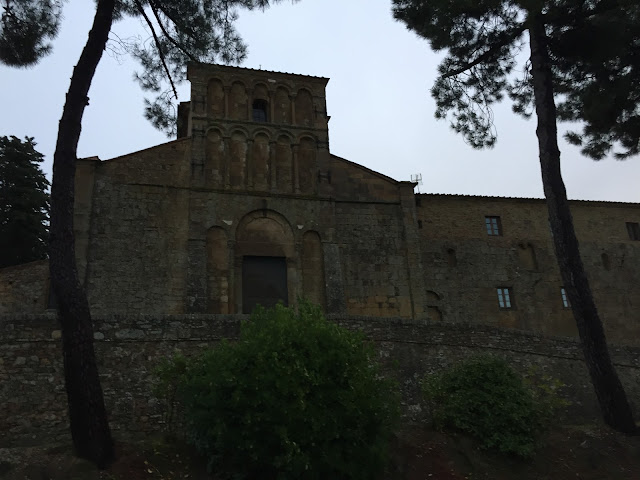 |
| The parish church of Santa Maria |
 |
| First mentioned in 988, Santa Maria was around when Sigeric traveled in 994! |
 |
| Little pilgrims |
 |
| I bought the ornament for my parents in Gambassi Terme |
The next day we woke up refreshed and met Marie again during breakfast! Unfortunately that was the last we'd see of the German girl as she was just a few days ahead of us for the remainder of our pilgrimage. One of my favorite things to do each night at a pilgrim hostel was read the recent entries in the pilgrim registry. Most nights we would be able to read Marie's notes from a night or two before us! Occasionally I would see an entry from another pilgrim I had met along the way-- I saw Prudence and Victoria's signatures several times (they were the Australian ladies I met way back in Châlons-en-Champagne!) They ended up arriving in Rome about two weeks ahead of me!
 |
| Good morning Gambassi Terme |
That day we were walking to San Gimignano. It was an incredible walk through beautiful Tuscan vistas with much better weather as well!
 |
| All sort of pilgrim symbols! |
One of Chad's favorite pastimes during this section was to walk behind me and throw cypress cones, trying to get them in between my pack and my back. Luckily I caught him in the act!
 |
| What?! |
 |
| The cypress trees prevalent in this area are stunning |
 |
| A little old lady on the road |
 |
| First view of San Gimignano |
Right when we arrived in San Gimignano there was a huge rain storm! Luckily we were sitting at a bar during the deluge!
The town of San Gimignano is a gorgeous medieval confection entirely finished in sandy stone. Even in the winter it is clearly a touristy town. I noticed immediately that everything was at least double the price of other places in Italy we'd walked through. Besides the expense, San Gimignano is a lovely medieval town with thirteen stone towers that rise over the town and give it a majestic view from afar.
 |
| Entry gate |
 |
| The picturesque well in Piazza della Cisterna |
 |
| San Gimignano Duomo |
 |
| Some of the Medieval towers on the Piazza del Duomo |
 |
| The well was made in 1237 |
We stayed at the 13th century Sant'Agostino Church in a room with gorgeous views of the surrounding landscape.
 |
| The Piazza di Sant'Agostino was very quiet |
 |
| The peaceful cloister |
 |
| View from our room looking over the stormy Tuscan countryside |
 |
| The next morning was much clearer! |
 |
| Goodbye San Gimignano |
Leaving San Gimignano the views proved just as spectacular as the day before. I kept looking behind me and taking pictures of the picturesque medieval town!
Finally the weather was a bit drier (even though later that day we did get caught in a rainstorm and had to pull out our ponchos and stand below some trees for a little bit) :(
We did have to ford several swollen rivers and Chad attempted to make a bridge once... with questionable success
 |
| He found the perfect log half a kilometer up the hill and promptly dragged it all the way to the river... |
 |
| Perfect! |
During the afternoon the clouds came back in. The roads were waterlogged and we kept having to skirt around small lakes in the middle of our path!
The town that night was a small hamlet that had grown up around the former Cistercian abbey of Abbadia dell'Isola. Half the town stood within the abbey's stone walls!
 |
| In the summer this field is full of sunflowers! |
 |
| Romanesque church |
The hostel we slept in was built inside the abbey's cloister and had opened just this year. It was very nice and clean with well built showers and large bunkbeds which Chad appreciated being the big guy he is!
From Abbadia dell'Isola we walked the five kilometers to Monteriggioni the next morning. Monteriggioni is a completely walled stone medieval town built on a hillock high enough that we could see it from Abbadia dell'Isola.
 |
| Monteriggioni |
 |
| So gorgeous! |
 |
| The 13th century town was compared in Dante's Divine Comedy to the infernal abyss-- equating the ring of towers to giants standing guard |
Monteriggioni is a gorgeous and tiny town with hardly more than a restaurant, store and church within it's walls. It also seemed to be quite the touristy town and a tour bus arrived just as we were leaving.
 |
| Little church |
 |
| A pilgrim resting park! |
We stopped at the local store to get our daily coffees and croissants. Chad had a mishap in the tiny bathroom in the store that did nothing to endear him to Italy or Europe as a whole...
 |
| Touristy store filled with Tuscan goods including the famous panforte! |
 |
| Away with you! I will not feed you treats! |
From Monteriggioni it was only a few hours walk into Siena!
 |
| The first sign with Roma!!! |
Finally we arrived in Siena! I had been looking forward to walking through Siena this whole trip! While Siena is well known today as a beautiful and popular tourist destination, it's history has been rather capricious. Siena was first settled by the Etruscans on top of several hills-- the Etruscans were known for their easily defended hill-top towns. During the Roman period, Siena was a rather backwater town as it was not near any Roman roads. After the Lombards conquered Siena in the early 7th century, the city prospered. Most northern trade as well as the majority of pilgrims coming from the northwestern lands then went through the city. During medieval times Siena and its main rival, Florence, were some of the biggest cities on the Italian Peninsula, growing even more important than Rome. Siena and Florence were constantly at each other's throats until the Black Death swept through medieval Italy and the population of Siena was decimated. That, combined with Siena's defeat at the hands of Florence in the 16th century, furthered the city's decline. This period of obscurity helped Siena remain a gem of Medieval architecture and contributed to its rise as a tourist destination in the 21st century!
 |
| Palazzo Pubblico |
The heart of Sienese life is the fan-shaped Piazza del Campo and Palazzo Pubblico. It is around this square that twice every summer the famous Palio horse race occurs. This Sienese tradition has its roots in medieval Sienese culture where the different Contrade (neighborhoods) of the city show their pride and race against each other to win the Palio, which is a banner portraying the Virgin. While this event is now very well known and touristy, it still retains the soul of its historical context which is the pride, rivalry and competition of the different Contrade of Siena.
The Palazzo Pubblico, beneath the Torre del Mangia, is a symbol of the independent republic of Siena and is a beautiful example of Gothic Italian civil architecture. Inside its walls are beautiful frescoes showing the famous 14th century
Allegory of Good and Bad Government by Ambrogio Lorenzetti. I love this fresco and even have a huge puzzle of it at home (I just completed it a week ago :P ) but Chad and I decided not to visit the museum this trip as we only had a finite amount of time in Siena.
 |
| Piazza del Campo |
 |
| Sienese sitting and enjoying the rare Fall sunlight |
 |
| The bell tower and dome of the Duomo can be seen from all over the countryside! |
We dropped our bags at the convent where we stayed for the next two nights and headed out to explore. The convent was only a five minute walk from the campo in the center of Siena! First thing on our list was the beautiful Duomo of Siena!
 |
| The tower of the Duomo can be seen from the Campo |
 |
| Walking up to the Duomo from Piazza del Campo |
The Siena Duomo is probably my favorite cathedral architecturally. It is just so aesthetically pleasing to look at. Both the exterior as well as the interior are grand and colorful. The Duomo was built in the early 13th century and completed with alternating white and black stone-- white and black being the traditional colors of Siena.
 |
| The inside feels so warm and rich |
The entire floor of the duomo is inlaid with marble mosaic pictures from the Bible. A few of these are uncovered all year round but from August to October (unfortunately we had just missed it!) the entire floor is uncovered for tourists to see!
 |
| We walked through Lucca, Siena, Viterbo and Rome. |
 |
| Some of the marble floor |
In the side aisle of the Duomo is the beautiful painted Piccolomini Library which is entirely covered in frescoes. This gorgeously intricate and colorful room had not a single space undecorated!
I always enjoy the backgrounds of these type of paintings. They always show fantastical fairy-like landscapes with beautiful cities, ethereal castles and magical forests!
 |
| I want to live in this castle! |
The ceiling is insanely intricate and detailed! I took a few pictures of some of the panels to show how fantastical and whimsical the designs are.
 |
| Satyrs |
 |
| Sea monsters |
That night Chad and I walked around the city. The temperature was actually quite cool and we decided we wanted to splurge on a nice dinner since this was one of the last rest days we would have in a big city. We chose the Gallo Nero which was on the way back to our convent from the Campo.
 |
| Gallo Nero |
As we walked in, a deluge of Asian tourists poured out of the restaurant. Seeing this, we were worried that the restaurant would be super busy, but after talking to the waitress we we told it had only been a group of 80 Asian tourists that, luckily, had just left! So we had the whole place to ourselves!
We decided on a predetermined traditional medieval Sienese menu! This was such an amazing meal!!!
We started with a traditional medieval bread that tasted rather "Christmas-y" to me. It contained lots of spices and anise and was a very hearty brown bread.
Following this was a beef carpaccio dish with roasted tomato.
Next was a traditional Sienese gnocchi with meat sauce.
This was followed by a hearty beef dish.
We finished the meal with a chocolate cake and rolled home to sleep medieval dreams of satiety.
 |
| A beautiful sunset |
 |
| Piazza del Campo at night |
The next day was our rest day and we began by stopping at a bar for our daily croissant and coffee.
 |
| Rings for tying horses |
We walked around Siena and watched the sun rise above the Palazzo Pubblico.
I bought some Panforte for a treat. This typical Sienese Christmas bread is aptly named "strong bread" and is a typically sweet and very dense bread filled with nuts and fruit. I loved it, though Chad seemed to be rather apathetic to it... more for me!!
 |
| Shopping for Panforte |
Siena is one of those cities that has been very much influenced by the Via Francigena. In the Middle Ages, Siena held numerous hospices for pilgrims traveling to and from Rome and in 1288 there were ninety documented innkeepers within the city limits!
 |
| Pilgrim road |
We decided to visit the Ospedale di Santa Maria della Scala next. This was the main civic hospital that cared for the poor, sick and pilgrims during the Medieval Ages and sits facing the Duomo facade. Built sometime between the 9th and 11th centuries this hospital is one of Europe's oldest surviving hospitals-- though now it is a museum.
 |
| Front of the medieval hospital |
We began our tour of the Ospedale in a room dedicated to photography of the Palio. This exhibit was phenomenal and the pictures captured the tension and poignant emotions of the Sienese Palio.
 |
| The horse is considered the victor of these races, not the rider |
 |
| The Palio is characterized by its intense rivalries |
 |
| At the end of each Palio a banquet is held in the streets |
The Ospedale holds a ton of history within its nooks and crannies. The biggest room on the ground floor shows the daily life of the Ospedale and is called the Pellegrinaio or "pilgrim hall" because it was once used to house pilgrims. Along its walls are frescoes that show the traditional services of the Ospedale.
 |
| Pilgrim's hall |
 |
| Endowing the hospital with walls |
 |
| Pope Celestine III grants autonomy to the hospital |
 |
| Paying the wet nurses their wages in grain |
 |
| Paying the wet-nurses their wages in money |
 |
| Caring for the sick |
 |
| Almsgiving |
 |
| I found this form of "crutches" very interesting! |
 |
| Rearing and Marrying of Female Foundlings |
We continued down into the complex of buildings until we reached the mildly creepy oratory used by the brotherhood of St Michael the Archangel. According to tradition, Saint Catherine of Siena is said to have come to these rooms to pray during her lifetime.
 |
| Mildly creepy skull |
 |
| It was dark and empty enough that we kept thinking we weren't supposed to be there! |
From the oratory we continued down into the bowels of Santa Maria into the section of the building where they keep the treasury. This section was a veritable maze winding its way further and further down inside the earth, quite easy to get lost and honestly quite creepy!
 |
| Someone's saintly blood! |
 |
| Stairwell into the bowels of the earth |
 |
| There were beautiful frescoes in some of the rooms |
As we wound our way back to the stairwell to return to the upper levels we passed by a charnel pit! Apparently the first cemetery for the hospital was located right within the Piazza del Duomo between the hospital and the cathedral! During the 14th century the cemetery in the piazza was covered with marble to allow people to use the area for daily life and business and the dead were then buried in other cemeteries.
During periods of plague, the dead were dumped into mass graves below ground and here is such a pit!!
Many pilgrims found their final resting places in these pits!
 |
| There must be hundreds of bodies here! |
From the deep recesses of the hospital Chad and I returned to ground level and entered an exhibition on WWI. This exhibition followed the experiences and photographs of 36 Italian soldiers from the Tuscan region as they fought on the Italian front. It was an incredibly moving exhibition and many of the pictures showed the brutality of soldier life in and out of the trenches.
From the Ospedale, Chad and I walked to a cafe to relax for the evening. I couldn't believe how close we were to Rome. I felt like I had blinked and Italy had slid by! Even the long boring fields of France felt like they had happened so quickly, it's amazing how experiences can slip away from us like that!
 |
| Testing out some Christmas glasses |
 |
| Rome, here we come!! |
Until next time!!


























































































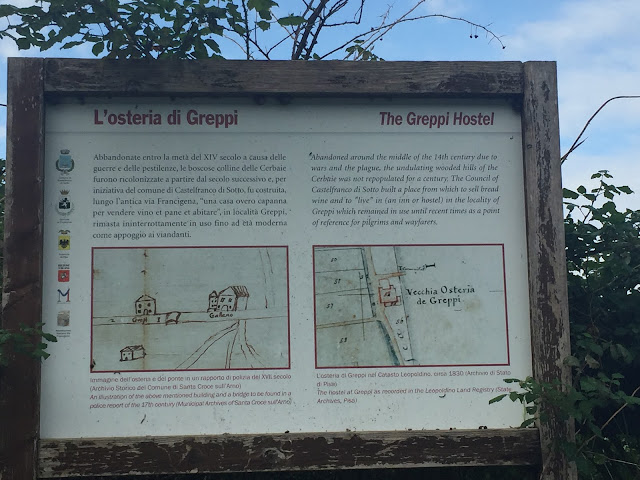

















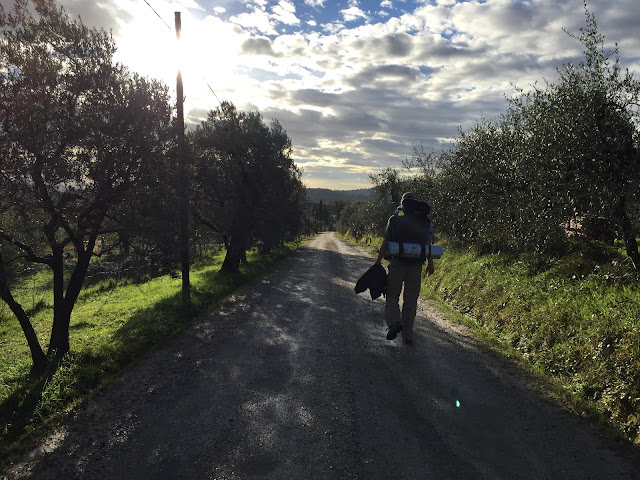



































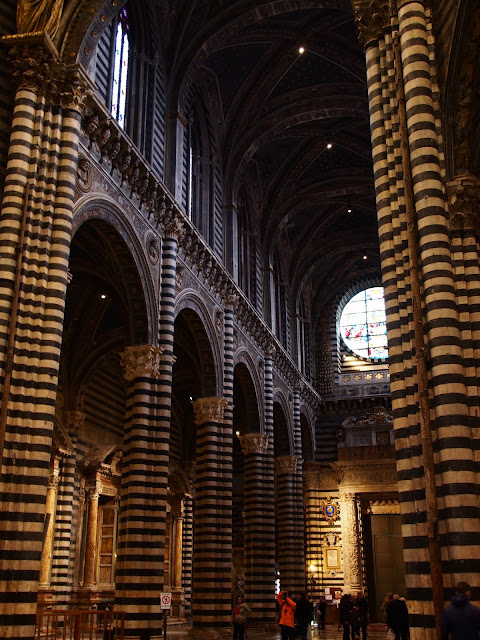





























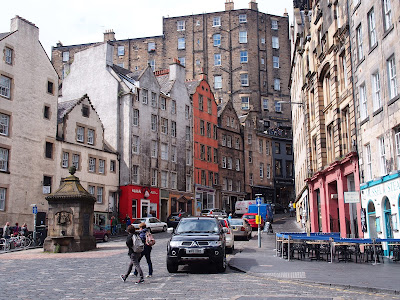
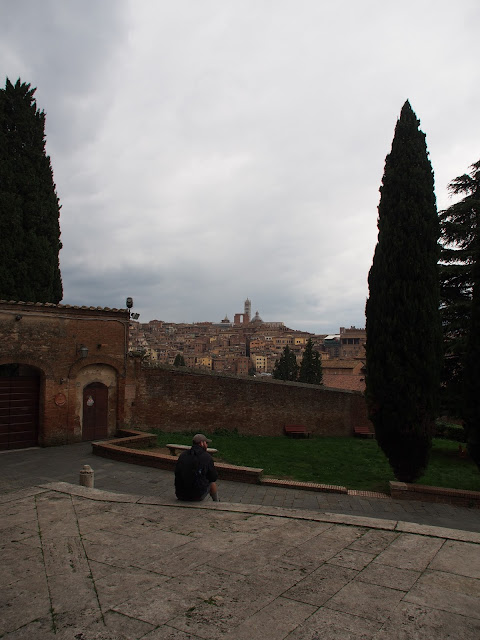

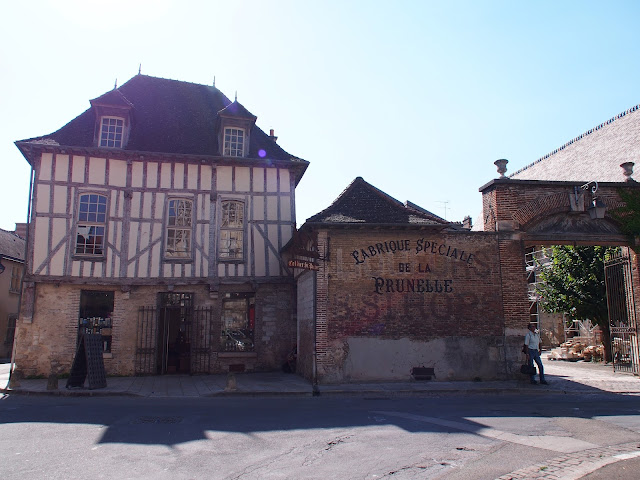



Comments
Post a Comment